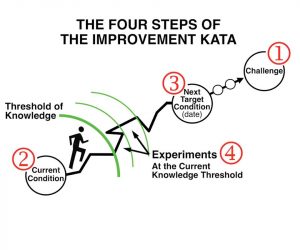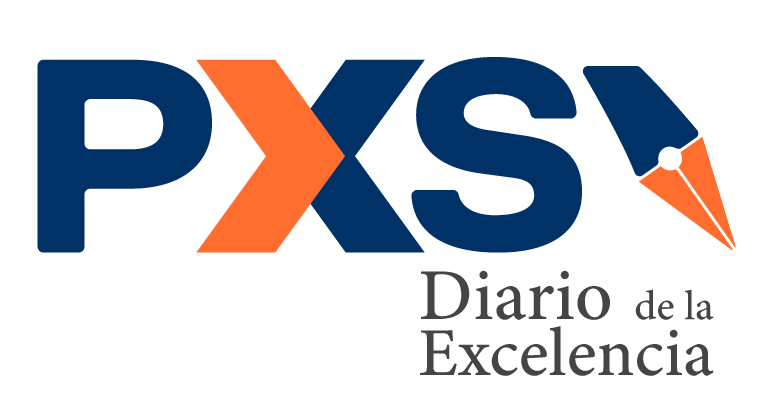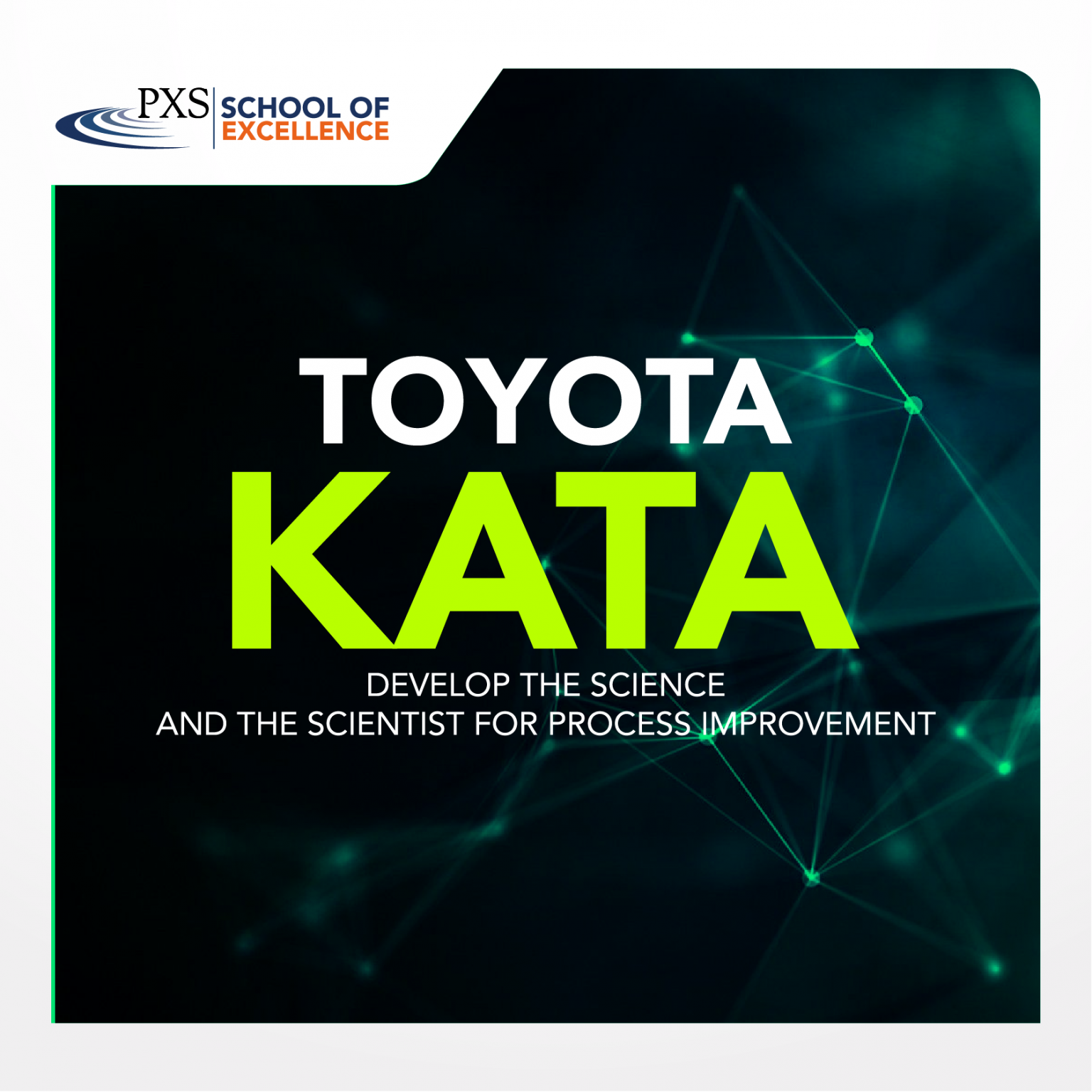The tool box is chock-full of specially designed implements that serve their unique purpose. Some tools do well at drilling down to root-cause while others specialize in summarizing activities for the variety of audiences. Toyota Kata or “Kata” for short, is a bit different than most lean tools in that it has a two-part objective, to drive process improvement, while adding specific emphasis in the development of the learners in the process.
This post is written after reading Mike Rother’s Toyota Kata, participating in the University of Michigan class The Improvement & Coaching Kata, and a few years of practice implementation. I highly recommend you also read his book and visit his open source website Mike Rother’s Toyota Kata Webpage. With that work citation in mind, I should clarify that this content is strictly my own opinion and not that of Rother.
I have broken the topic of Kata into three parts
- Introduction & Overview
- Improvement Kata
- Coaching Kata
In this first post, I will share a simple Introduction & Overview of Kata, how it is similar to other lean tools, and how is distinct. You will soon see that Kata sets a path for learning which takes the scientist beyond the execution of already established best practices and dives into the layers of uncertainty. As a backdrop, I will refer to some of the neuroscience behind the Kata approach. Then to better prepare you for the upcoming posts I’ll share of the key terms used by Rother in his Kata related literature and videos. As I often do, I will compare this tool to the Shingo Principles.
KATA OVERVIEW:
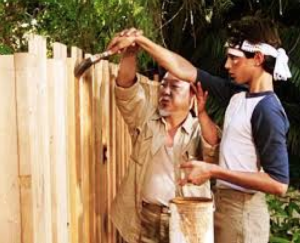 A metaphoric example of the Kata approach is found in the classic movie, The Karate Kid. Daniel is determined to defend himself against his teenage bullies by learning the art of karate. His sensei, Mr. Miyagi sets forth, not just to teach Daniel the answers to his questions, but to teach the method of learning all future learnings related to the art. Daniel learns to establish a “kata”, a pattern or cadence of learning.
A metaphoric example of the Kata approach is found in the classic movie, The Karate Kid. Daniel is determined to defend himself against his teenage bullies by learning the art of karate. His sensei, Mr. Miyagi sets forth, not just to teach Daniel the answers to his questions, but to teach the method of learning all future learnings related to the art. Daniel learns to establish a “kata”, a pattern or cadence of learning.
HOW KATA IS DIFFERENT:
Kata at its core, stretches some fundamental paradigms we typically rely on in classic lean, six sigma, and Operational Excellence discussions. None of these tools are discarded, but many of them have new context and may be leveraged differently than in the past. I will share some examples, but they will not totally make sense until you dive deeper into all three blog posts… so be patient!
Below are some examples of classic lean terms that shift paradigms within a Kata approach:
Implementation –
This is typically felt as a positive thing. It’s when you decide the next best course of action and now its time to “Go & Do”. It has a keen sense of ‘execution’. The traditional use of ‘implementation’ implies that you know with certainty the current state as well as the solution that will carry you to your desired future state. The book “Learning to See” (interestingly written in part by the same Rother) can leave us to feel that after you map the current state and brainstorm a future state map with some clever icons, it’s now simply a matter of execution or ‘implementation’. Kata offers an iterative method to get from current state to future state. All that said, I have found that certainly there are occasions to simply “Go & Do”. When the solution is clear, then a Kata approach may not be necessary. However, when the solution set is not linear or well defined, then we may be better to not rush into implementation.
Countermeasures –
This term refers to the discrete and determined action that will be taken to restore the needed behavior or outcome. We will often see an entire section of an A3 dedicated to countermeasures. This term is useful to establish the bulleted tasks that was decided to restore balance or to achieve steady state. The problem is in the assumption that the actions will work…. Often, we trust problems to be solved by a level higher than our selves. Simply put, we expect to be told what to do. Similarly, as leaders we often feel a need to provide the answer to problems. Again, the challenge is that in the paradigm that the leaders know enough of the gemba to make such determinations. Implicit is an assumption that the line level associates in fact don’t have the solutions. You can see where this vicious cycle can perpetuate less effective solutions sets. In those cases, we can note that the Shingo principles at the base of the pyramid, “Respect Every Individual & Lead with Humility” are not being honored. Kata, we will later see, accepts that corrective actions will be taken but adds an iterative and scientific method to determining those actions. Moreover, the small steps may be derived from the Learner, not just from the Coach
Standards –
In lean, we rely greatly on the use of documented standards to maintain constancy of process control. This discipline is sound and required. The risk of this paradigm is that standards can sometimes become an impediment for improvement or growth. At times, the Standard Operating Procedure (SOP) becomes law only to be changed by acts of congress. This perceived rigidity to standards can get in the way of controlled experimentation and process evolution. Kata provides a method of controlled, communicated, confirmed process change while maintaining the appropriate documentation or standards. Again, standards still do absolutely exist within a Kata approach, but with a different paradigm.
Kata offers similar change in context or paradigms around other lean tools such Workshops, Value Stream Mapping, Action item lists, 1 piece flow, Takt time, and Kaizen events.
SO WHEN KATA?:
So, if all these tools are valid and useful, when would you want to apply a more Kata style approach? These traditional lean tools are most effective when the problem being attacked is relatively straight forward, when there exist sound industry or company best practices, and even when execution is honestly more critical than the learning. Sometimes it’s simply more urgent to “get-it-done” than it is to get the optimal solution with the ideal learning. That said, other challenges are not so linear in nature nor have a defined “how” associated to the “what” that needs to be accomplished. Kata is best applied where the organization is seeking significant people development along with significant process improvement. Kata does well at integrating various iterations of Plan, Do Check, Adjust (PDCA) steps or experiments in a fashion that gets rapid yet incremental results in a controlled and well communicated environment.
ZONE OF UNCERTAINTY
When facing a challenge, we have a certain set of conditions that are known and a set of conditions that are desired. The fuzzy matter in between is space that can be thought of as a “Zone of Uncertainty”. This grey zone is where a kata or cadence or pattern of experiments will progress us upward towards our goal, yet is not a linear path.

NEUROSCIENCE:
There is sound science behind the Kata method. “Neuroplasticity” is the term that describes the human brain’s ability to change, to gain new or different habits throughout life. Simply put, “anytime you do something, you are more likely to do it again”. It’s really that simple. To acquire a new skill or habit (in our case, if we want to learn to systematically approach problem solving in this Kata approach) we can rewire our brains to do so. Here are the ingredients (taken directly from Rother’s Toyota Kata page):
- A structured routine for beginners to practice
- Frequent repetition
- Feedback & correction from a coach
- Optimism from feeling we have overcome obstacles and made progress.
Within the framework of Kata, this means that the learner can rewire their brains to approach problems in a systematic, iterative, incremental, and organized way. While also, the Coach can rewire her brain to teach by a Socratic, pull vs push, organic yet methodical way. More to come in next blog about that specific coaching method termed “Coaching Kata”.
KATA TERMS:
Mike Rother has borrowed some classic lean terms, has modified other terms, and totally invented yet some others. I want to provide a simple translation guide to those terms to facilitate the understanding of his content in his books and on his website. I will take liberty to add my application to his definitions. You will see strong similarities between these tools and the Continuous Improvement Shingo principles.
IMPROVEMENT KATA: Learning pattern or routine. This is the methodology of practicing and thus learning to achieve business goals through using the scientific method. This is the thought process that the Learner uses to gain insight beyond what is currently known.
COACHING KATA: Routine by which you teach the Improvement Kata. Every Learner needs a Coach. It may be formalized or not. In the early phase of adopting Kata, this should be formalized. However, you don’t have to be expert to accept the role of Coach.
FIVE QUESTIONS: The pre-scripted Socratic method by which the Coach walks the Learner thru the Improvement Kata. Don’t get hung up on the number 5. Like the “5 whys” tool, the point is that the coach and the Learner know exactly what questions will be asked. The rigid structure helps establish a routine of learning.
VISION: A simple true north statement. This should be simple, lofty, and its ok to be vague. Ex. Improve the production capacity in the x-value stream in order to meet the forecasted spike in demand.
CHALLENGE: A long term business objective. Should be specific S.M.A.R.T. type goal. The challenge is an objective that is currently out of reach. If you already know how to get there, it may not be an applicable Kata Challenge. Ex. Improve our production rate by 500 trays to 600 trays per shift, maintaining current labor cost, by Dec 31.
TARGET CONDITION: A set of business parameters, subjective and quantitative, that describe the desired state. Avoid single facetted KPI goals. Yet also avoid goals that lack quantitative measures. A condition considers that set of both measured and procedural results. Ex. Establish a workflow in the inspection area that is both planned and leveled. “Levelled” is measured by (…fill in the blank). Reach by Dec 31.
CURRENT CONDITION: A set of business parameters, subjective and quantitative, that describe the current state. Its preferred that the current condition is described in the same or similar parameters as the target condition. Current condition is represented by process maps, standard work, and data charts. Ex. Current work is 80% unplanned and more than x hours unleveled. Include actual trend chart, simple block chart, etc.
GO SEE: Gemba. Rother makes the point frequently to gemba the experiment site as opposed to relying on system data alone. When in doubt, go to the gemba site in person and observe the work, live and in person.
OBSTACLES: Clearly defined processes, factors, salient points that are in the way of achieving your target condition. It’s fine to have multiple obstacles listed in the parking lot. The kata model will drive the selection of which obstacle that will be addresses next. Ex. 1. Deliveries come in batches, 2. Interruptions of associates, 3. Occasional high rejection rate, 4. Members are not all cross-trained.
BLOCK CHART: Simplified Value Stream Map. Very high level process map with the VSM mentality.
PDCA: Plan, Do, Check, Adjust cycle. This is the heart of the scientific method. Kata emphasizes the use of rapid hypothesis testing. This leads to few key points; test over talk & theory, tests are adaptive, hypotheses are often wrong, and a wrong hypothesis can teach more than a correct one.
KATA BOARD: Adapted A3 style whiteboard that displays visually the various components shared in an Improvement Kata project. The format facilitates the Five Question Q&A discussion between the Coach and the Learner.
NEUROPLASTICITY: The brain science concept that indicates that our brains are highly adaptive, however do don’t change habits without a routine (kata). We can rewire our brains with Structure, Repetition, Feedback, Optimism from Success. Kata sets a routine for these Improvement & Coaching Kata.
TOYOTA: Rother frequently sites Toyota and their culture to establish credibility for his approach which he codifies as “Kata”. I observe that you must start with your company culture and find common principles that you have with Toyota or Shingo and build from there. Kata fits in a variety of cultures, not just in Toyota.
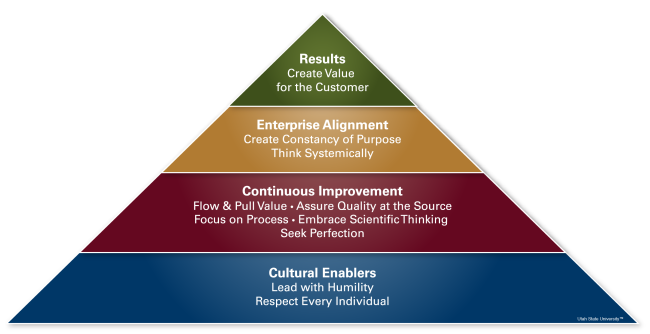
IMPROVEMENT KATA, COACHING KATA, & SHINGO
The next blog posts will dive into the specifics The Improvement Kata that the Learner follows to improve her process by following the scientific method. This is the model of “how to learn”. In the third blog post, I will share the other half of the riddle, The Coaching Kata or “how to teach”. Like Socrates, the Kata Coach will need to pull for learning rather than push the answers. Together the Improvement Kata and the Coaching Kata build on the most fundamental Shingo Principle of Respect Every Individual. This principle guides how the learning and coaching takes place. The format of the Kata facilitates and leverages Continuous Improvement, and in a hoshin-style fashioned pulls Alignment across the enterprise. Ultimately the process generates a cycle of learning and improvement that turns out rapid yet incremental results which in turn perpetuates a culture of respect, process improvement, and improved business outcomes.
